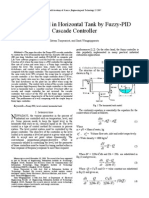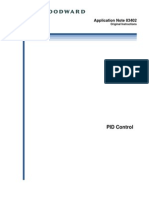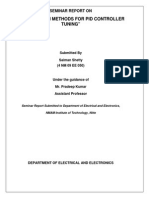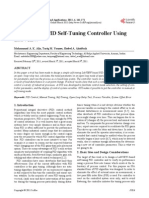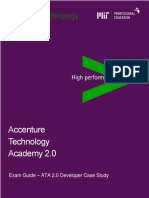Chapter 1 - Introduction To Process Control (I-Learn)
Uploaded by
Loong TaufiqChapter 1 - Introduction To Process Control (I-Learn)
Uploaded by
Loong TaufiqESE 356
INDUSTRIAL INSTRUMENTATION
(LECTURE NOTES)
Prepared By :
MOHD ASWAD BIN HJ AMAT MUSHIM
Lecturer/Coordinator
NOR AZLAN OTHMAN
Lecturer
SAIFUL ZAIMY YAHAYA
Lecturer
FAKULTI KEJURUTERAAN ELEKTRIK
UNIVERSITI TEKNOLOGI MARA
PULAU PINANG
ESE356
IndustrialInstrumentation TableofContents
PreparedBy:
MohdAswadHjAmatMushim Pagei
CONTENTS
Chapter 1 Introduction to Process Control System
1.1. Introduction
1.1.1. Definition
1.2. Process Control Principle
1.2.1. Process Control Principles
1.2.2. The Process
1.2.3. Human Aided Control
1.2.4. Automatic Aided Control
1.3. Process Control Block Diagram
1.3.1. Process Control Block Diagram
1.3.2. Process
1.3.3. Measurement
1.3.4. Error Detector
1.3.5. Controller
1.3.6. Control Element
1.4. Example of Common Instrumentation Used in
Process Industry
1.4.1. Common Instrumentation
1.4.2. Sensors
a. Thermal sensors
b. Mechanical sensors
1.4.3. Control Valves
1.5. Tutorial & Assignment
Chapter 2 Principles and Operation of Measuring Element
2.1. Definition
2.1.1. Sensor
2.1.2. Transducer
2.1.3. Sensor & Transducer
2.2. Application of Common Industrial Transducers
2.2.1. Common Transducers
2.3. Thermal Sensors
2.3.1. Metal Resistance versus Temperature
Devices
2.3.2. Resistance Temperature Detector (RTD)
2.3.3. Thermistor
2.3.4. Thermocouple
2.3.5. Bimetal Strip
2.4. Mechanical Sensors
2.4.1. Displacement, Location and Position Sensors
2.4.2. Strain Sensors
2.4.3. Motion Sensors
2.4.4. Pressure Sensors
2.4.5. Flow Sensors
2.5. Tutorial & Assignment
Chapter 3 Principles and Operation of Signal Conditioning
3.1. Principle & Operation of Signal Conditioning &
Transmitter
3.1.1. Signal Level & Bias Changes
3.1.2. Linearization
3.1.3. Conversion
3.1.4. Filtering & Impedance Matching
3.1.5. Concept of Loading
3.2. Passive Circuits
3.2.1. Divider Circuit
3.2.2. Bridge Circuit
a. Wheatstone Bridge
b. Galvanometer Detector
3.3. Operational Amplifier
3.3.1. Transfer Function
3.3.2. Op-Amp Circuit in Instrumentation
a. Voltage Follower
b. Inverting Amplifier
c. Non-Inverting Amplifier
d. Differential Amplifier
e. Instrumentation Amplifier
3.4. Active Filters
3.4.1. Low Pass Filters
3.4.2. High Pass Filters
3.4.3. Band Pass Filters
3.5. Converters
3.5.1. Introduction
3.5.2. Represent of Analog Signal in Digital Form
3.5.3. Analog to Digital Converter (ADC)
a. Dual Slope Conversion
b. Ladder Network Conversion
3.5.4. Digital to Analog Converter (DAC)
a. Ladder Network Conversion
3.6. Tutorial & Assignment
Chapter 4 Principles and Operations of Signal Conversion
and Actuator
4.1. Introduction
4.1.1. Introduction
4.1.2. Elements of Final Control Operation
4.1.3. Signal Conversion
4.1.4. Actuators
4.1.5. Control Element
4.2. Signal Conversion
4.2.1. Signal Conversion - Electrical Signals
4.2.2. Signal Conversion Pneumatic Signals
4.3. Electrical Actuator
4.3.1. Solenoid
4.3.2. Electrical Motor
4.3.3. AC Motor
4.3.4. DC Motor
4.3.5. Stepping Motor
ESE356
IndustrialInstrumentation TableofContents
PreparedBy:
MohdAswadHjAmatMushim Pageii
4.4. Mechanical Actuator Pneumatic Actuator
4.4.1. Pneumatic Supply System
4.4.2. Principle Operation of Pneumatic System
4.5. Mechanical Actuator Hydraulic Actuator
4.5.1. Hydraulic Power Supply
4.5.2. Principle Operation of Hydraulic System
4.5.3. Hydraulic Regenerative Circuit
4.6. Tutorial & Assignment
Chapter 5 Principles and Operations of Control Elements
5.1. Control Element - Electrical
5.1.1. Motor Speed Control
5.1.2. Temperature Control
5.2. Control Element Fluid Valves
5.2.1. Introduction
5.2.2. Basic Principle of Liquid Flow
5.2.3. Control Valve Principles
5.2.4. Flow Control Valve
5.2.5. Valve Body and Plug
5.2.6. Control Valve Types
a. Quick Opening
b. Linear
c. Equal Percentage
5.2.7. Control Valve Sizing
5.3. Control Valve Basic Construction & Application
5.3.1. Control Valve
5.3.2. Graphical Symbol
5.3.3. Control Valve Classification
a. Two Port Two Position valve
b. Three Port Two Position valve
c. Four Port Two Position valve
d. Five Port Two Position valve
5.3.4. Types of Control Valve
a. Poppet Valves
b. Spool Valves
c. Rotary Valves
5.4. Common Types of Cylinder
5.4.1. Single Acting Cylinder
5.4.2. Spring Return Cylinder
5.4.3. Ram Cylinder
5.4.4. Double Acting Cylinder
5.4.5. Double Acting / Double Rod Cylinder
5.5. Common Types of Actuators
5.5.1. Valve Actuator
5.5.2. Linear Actuator
5.5.3. Rotary Actuator
5.6. Tutorial & Assignment
Chapter 6 Virtual Instrument
6.1. Introduction to Graphical User Interface (GUI) and
Virtual Instrument
6.1.1. Introduction to Graphical User Interface and
Virtual Instrument
6.1.2. Introduction to LabVIEW Virtual Instrument
6.1.3. Graphical Programming
6.1.4. Connectivity and Instrument Control
6.1.5. Analysis Capabilities
6.1.6. Visualization Capabilities
6.1.7. Flexibility and Scalability
6.1.8. DAQ Instrument Control in LabVIEW
6.1.9. Conclusion
6.2. Introduction of Data Acquisition System
6.2.1. Introduction of DAS
6.2.2. Objective of DAS
6.3. Single Channel and Multi Channel DAS
6.3.1. Single Channel Data Acquisition System
6.3.2. Multi Channel Data Acquisition System
a. Multi Channel Analog Multiplexed
System
b. Multiplexing the Output of S/H
c. Multiplexing After ADC
6.4. Computer Based DAS
6.4.1. Computer Based DAS
6.4.2. DAS Aids Operation
6.5. Data Logger
6.5.1. Data Logger
6.5.2. Data Logging versus Data Acquisition
6.6. Examples of DAS and Data Logger
6.6.1. minilab 1008
6.6.2. USB Based 1208FS
6.6.3. 10 Channel Midi Data Logger
6.6.4. GL1100 Hard Disc Logger
6.7. Tutorial & Assignment
ESESS6 Chaptei 1
Inuustiial Instiumentation Intiouuction to Piocess Contiol System
Piepaieu By:
Nohu Aswau Bj Amat Nushim Page 1
Chapter 1
Introduction to Process Control System
1.1 Introduction
1.1.1 Definition
Control means methods to force parameters in the environment to have specific value.
Control system means all the elements necessary to accomplish the control objective.
1.2 Process Control Principle
1.2.1 Process Control Principles
In process control, the basic objective is to regulate the value of some quantity.
Regulate is a process to maintain the quantity at same desired value regardless of
external influences.
Desired value is called refer value or set point.
1.2.2 The Process
Figure 1.1 shows the process to be used to regulate the level of liquid in the tank, h to
the value H.
It is known that Q
out
varies with h.
0
out
= k.(b)
Higher the level h, the faster the liquid flow out Q
out
.
b l = 0
out
l
If Q
out
> Q
in
tank will empty
If Q
out
< Q
in
tank will overflow
Suppose we want to maintain the liquid level at some particular value, H regardless
of the input flow Q
in
. Then something more than self-regulation is needed.
ESESS6 Chaptei 1
Inuustiial Instiumentation Intiouuction to Piocess Contiol System
Piepaieu By:
Nohu Aswau Bj Amat Nushim Page 2
Figure 1.1 : Tank Level Control
Where Q
in
= input flow rate
Q
out
= input flow rate
h = liquid level / height
H = level set point
1.2.3 Human Aided Control
Figure 1.2 shows a modification of the tank system to allow artificial regulation of the
level by human.
Figure 1.2 : Human Aided Control
ESESS6 Chaptei 1
Inuustiial Instiumentation Intiouuction to Piocess Contiol System
Piepaieu By:
Nohu Aswau Bj Amat Nushim Page S
Human can regulate the level using a sight tube to compare the level h, to the set point,
H (adjust the value of valve opening to change the level).
If h > H open the valve a little to let the flow out increase and thus the level h lower
than set point, H.
If h < H close the valve a little to decrease the flow & towards the set point, H.
1.2.4 Automatic Aided Control
Sensor is added to measure the value of the level convert it to proportional signal, s.
This signal, s provided as input to a machine, electronic circuit, and computer called
controller.
Controller performs the function of human in evaluating the measurement and providing
an output signal, u to change the value setting via actuator connected to the valve by a
mechanical linkage.
When automatic control is applied to system like Figure above, which is designed to
regulate the variable to a set point, it is called Process Control.
Figure 1.3 : Automatic Aided Control
ESESS6 Chaptei 1
Inuustiial Instiumentation Intiouuction to Piocess Contiol System
Piepaieu By:
Nohu Aswau Bj Amat Nushim Page 4
1.3 Process Control Block Diagram
1.3.1 Process Control Block Diagram
Figure 1.4 shows a general block diagram constructed from all the basic elements and
signals involved.
The control variable is denoted by c in this diagram and the measured representation of
the controlled variable is labeled b.
The controlled variable set point is labeled r for reference.
The controller uses the error input to determine an appropriate output signal p, which is
provided as input to the control element.
The control elements operate on the process by changing the value of the controlling
process variable u.
The error detector is a subtracting-summing that outputs an error signal e = r b, to the
controller for comparison and action.
Figure 1.4 : General Process Control Block Diagram
1.3.2 Process
A process can consist of a complex assembly of phenomena that relate to some
manufacturing sequence.
Many variables may be involved in such a process & it may be desirable to control
these variables at the same rate.
Single variable processed only one variable is to be controlled.
Multivariable processed many variables are to be controlled.
The process is also called the plant.
ESESS6 Chaptei 1
Inuustiial Instiumentation Intiouuction to Piocess Contiol System
Piepaieu By:
Nohu Aswau Bj Amat Nushim Page S
1.3.3 Measurement
Measurement is the conversion of the variable into some corresponding analog of the
variable, e.g. pneumatic pressure, electrical voltage, and current.
Why? To affect control of a variable in a process, we must have information about the
variable. Variable is found by measuring the variable.
Sensor is a device that performs the initial measurement and energy conversion of a
variable into analogous electrical or pneumatic information.
The sensor is also called a 'transducer'. The word sensor is referred to the initial
measurement device. However, transducer means a device that converts any signal
from one to another.
All sensors are transducers but not all transducers are sensors. E:g. a device that
converts a voltage into a proportional current would be a transducers.
Signal conditioning maybe required to complete the measurement. The result of the
measurement is a representation of a variable value in some form required by the other
elements in the process-control operation.
1.3.4 Error Detector
Detect the difference between the actual measurement and the set point and deduced
the error.
e = H h
This error has both a magnitude and polarity.
e.g. Set point, H = 5.0 m
Liquid level, h = 5.7 m
Error, e = 5.0 5.7 m
= -0.7 m
Thus the error has a magnitude 0.7 m and negative (-ve) polarity or h > H.
1.3.5 Controller
The next step in the process control sequence is to examine the error & determine the
action should be taken.
This evaluation may be performed by an operator such as electronic signal processing,
pneumatic signal processing or by computer, e.g. using microprocessor-based
controller.
ESESS6 Chaptei 1
Inuustiial Instiumentation Intiouuction to Piocess Contiol System
Piepaieu By:
Nohu Aswau Bj Amat Nushim Page 6
The controller requires:
a. A measured indication of the controlled variable, e.g. liquid level, h.
b. Reference value of the variable, H (set point).
1.3.6 Control Element
Final element in the process control operation.
Control element is a device that imposes a direct influence on the process.
It provides those required changes in the controlled variable to bring it to the set point.
This element accepts an input from the controller, then transforms into some
proportional operation performed on the process, e.g. valve.
This element is also called 'final control element'.
Normally, an intermediate operation is required between controller output and the final
control element. This operation is referred to as an actuator.
Actuator uses the controller signal to actuate the final control element.
It translates the small energy signal to actuate the final control element.
1.4 Example of Common Instrumentation Used in Process Industry
1.4.1 Common Instrumentation
Sensors and valves are most common instrumentation used in process industry.
Sensors are use to measure process conditions and valves to influence process.
Engineers want to design and operate processes that remain in safe conditions,
produce the desired amounts of high quality products and are profitable. Therefore,
engineers must provide measuring devices for key variables and valves (or other
devices, such as variable speed electric motors) to influence of steer the process.
While sensors and valves are important in all aspects of engineering, they assume
greatest importance in the study of automatic control, which is termed process control
when applied in the process industries.
Process control deals with the regulation of processes by applying the feedback
principle using various computing devices, principally digital computation.
Process control requires sensors for measuring variables and valves for implementing
decisions. Therefore, the presentation of this material is designed to complement other
learning topics in process control.
ESESS6 Chaptei 1
Inuustiial Instiumentation Intiouuction to Piocess Contiol System
Piepaieu By:
Nohu Aswau Bj Amat Nushim Page 7
1.4.2 Sensors
a. Thermal sensors
Temperature control is important for separation and reaction processes, and
temperature must be maintained within limits to ensure safe and reliable
operation of process equipment.
Temperature can be measured by many methods using some sensors such as
thermocouple, resistor temperature detector (RTD) and thermistor.
b. Mechanical sensors
The class of sensors used for the measurement of mechanical phenomena is of
special significance because of the extensive use of these devices throughout
the process control industry.
In many instances, an interrelation exists by which a sensor designed to
measure some mechanical variable is used to measure another variable.
Few types common mechanical sensors can be described as below :
Displacement, location or position sensors
Strain sensors
Motion sensors
Pressure sensors
Flow sensors
1.4.3 Control Valves
Control valves is the choice for many flow control in the process industries.
Valve with a variable opening for flow is the standard equipment used to introduce this
variable resistance for the flow control.
The valve is selected because it is simple, reliable, relatively low cost and available for
a wide range of process applications.
In some cases the valve resistance is set by a person adjusting the opening, like a
home water tap or faucet.
In many cases the valve resistance is determined by an automatic controller, with the
valve designed to accept and implement the signal sent from the controller.
The objective of control valve is to describe the key features of common valves and
provide guidance on proper selection and sizing.
ESESS6 Chaptei 1
Inuustiial Instiumentation Intiouuction to Piocess Contiol System
Piepaieu By:
Nohu Aswau Bj Amat Nushim Page 8
1.5 Tutorial and Assignment
1.5.1 Process Control principle
1) Define the terms of control and control system.
2) Describe the process control principle.
3) State the main difference between automatic and manual process control. (Oct 2009).
4) With an appropriate diagram and example, explain how to control a process using
human aided control and automatic control.
1.5.2 Process Control Block Diagram
1) Draw a general process control block diagram. In a point form, explain each component
of the block diagram.
2) Error detector is use to detect the difference between the set point and measured point.
With an appropriate example, explain how this error detector works.
3) Control element is an important part in the process control. Base on the process control
block diagram in the notes, explain how the control element works.
1.5.3 Example of Common Instrumentation Used in Process Industry
1) Name two common instruments that used in process industry.
2) Give three (3) examples of thermal sensor and mechanical sensor.
3) State two (2) control valve function.
You might also like
- DEN5200 CONTROL SYSTEMS ANLAYSIS AND DESIGN Report100% (1)DEN5200 CONTROL SYSTEMS ANLAYSIS AND DESIGN Report15 pages
- Lab 6 Engineering Measurement and Lab SampleNo ratings yetLab 6 Engineering Measurement and Lab Sample11 pages
- Unit No - II: Block Diagram RepresentationNo ratings yetUnit No - II: Block Diagram Representation56 pages
- Level Control in Horizontal Tank by Fuzzy-PID Cascade ControllerNo ratings yetLevel Control in Horizontal Tank by Fuzzy-PID Cascade Controller5 pages
- EngM513 LAB Manual Automatic Control EngineeringNo ratings yetEngM513 LAB Manual Automatic Control Engineering23 pages
- Designing of Fuzzy Logic Controller For Liquid Level ControllingNo ratings yetDesigning of Fuzzy Logic Controller For Liquid Level Controlling10 pages
- Research Article: Cathodic Protection of Pipeline Using Distributed Control SystemNo ratings yetResearch Article: Cathodic Protection of Pipeline Using Distributed Control System8 pages
- The Level Control of The Boiler Drum: Chenhui HeNo ratings yetThe Level Control of The Boiler Drum: Chenhui He32 pages
- 2018Ch85 - Pressure Controller FInal LabNo ratings yet2018Ch85 - Pressure Controller FInal Lab12 pages
- Vertical Separator Control and Instrumentation RepeatNo ratings yetVertical Separator Control and Instrumentation Repeat12 pages
- Practices Manual: 7.1 General Description of The SystemNo ratings yetPractices Manual: 7.1 General Description of The System18 pages
- Practices Manual: 7.1 General Description of The SystemNo ratings yetPractices Manual: 7.1 General Description of The System18 pages
- Introduction To Hydraulics, Servo Drive and PLC100% (1)Introduction To Hydraulics, Servo Drive and PLC5 pages
- A Design of A PID Self-Tuning Controller Using Labview: Mohammad A. K. Alia, Tariq M. Younes, Shebel A. AlsabbahNo ratings yetA Design of A PID Self-Tuning Controller Using Labview: Mohammad A. K. Alia, Tariq M. Younes, Shebel A. Alsabbah11 pages
- The Book of (PLC & SCADA) Dosing System by HMINo ratings yetThe Book of (PLC & SCADA) Dosing System by HMI102 pages
- LabExercise 9 - Dynamic Systems SimulationNo ratings yetLabExercise 9 - Dynamic Systems Simulation16 pages
- Arduino Based Automatic Pneumatic SystemNo ratings yetArduino Based Automatic Pneumatic System31 pages
- Technical Report Lab 9 - Automated Measurement of Flow Rate, Pressure and Level of Bath Recirculation SystemNo ratings yetTechnical Report Lab 9 - Automated Measurement of Flow Rate, Pressure and Level of Bath Recirculation System15 pages
- Two Tank Non-Interacting Liquid Level SystemNo ratings yetTwo Tank Non-Interacting Liquid Level System9 pages
- Signals and Control Systems: Application for Home Health MonitoringFrom EverandSignals and Control Systems: Application for Home Health MonitoringNo ratings yet
- Control of DC Motor Using Different Control StrategiesFrom EverandControl of DC Motor Using Different Control StrategiesNo ratings yet
- Sliding Mode Control of Uncertain Parameter-Switching Hybrid SystemsFrom EverandSliding Mode Control of Uncertain Parameter-Switching Hybrid SystemsNo ratings yet
- ALVgrid Example With CL - Gui - Alv - Grid and Screen PainterNo ratings yetALVgrid Example With CL - Gui - Alv - Grid and Screen Painter6 pages
- Martin Schroder Design Patterns Virtual API Pattern 0.38.0No ratings yetMartin Schroder Design Patterns Virtual API Pattern 0.38.08 pages
- The State of Application Security q2 2023No ratings yetThe State of Application Security q2 202314 pages
- Doc-20231219-Wa0034. 20231219 164426 0000No ratings yetDoc-20231219-Wa0034. 20231219 164426 000031 pages
- Software Requirements Modeling and Design: CS/SWE 321 Dr. Rob Pettit Fall 2014No ratings yetSoftware Requirements Modeling and Design: CS/SWE 321 Dr. Rob Pettit Fall 201459 pages
- Software Processes: ©ian Sommerville 2004 Slide 1No ratings yetSoftware Processes: ©ian Sommerville 2004 Slide 150 pages
- Chapter 2: The Development of Enterprise Resource Planning Systems100% (1)Chapter 2: The Development of Enterprise Resource Planning Systems18 pages
- Probe Software For Machine Tools Data Sheet - Program FeaturesNo ratings yetProbe Software For Machine Tools Data Sheet - Program Features20 pages
- QR 774/15 DEC/GRU-DOH: - Not For Real World NavigationNo ratings yetQR 774/15 DEC/GRU-DOH: - Not For Real World Navigation70 pages
- DEN5200 CONTROL SYSTEMS ANLAYSIS AND DESIGN ReportDEN5200 CONTROL SYSTEMS ANLAYSIS AND DESIGN Report
- Advanced Process Control: Beyond Single Loop ControlFrom EverandAdvanced Process Control: Beyond Single Loop Control
- Level Control in Horizontal Tank by Fuzzy-PID Cascade ControllerLevel Control in Horizontal Tank by Fuzzy-PID Cascade Controller
- Designing of Fuzzy Logic Controller For Liquid Level ControllingDesigning of Fuzzy Logic Controller For Liquid Level Controlling
- Research Article: Cathodic Protection of Pipeline Using Distributed Control SystemResearch Article: Cathodic Protection of Pipeline Using Distributed Control System
- Vertical Separator Control and Instrumentation RepeatVertical Separator Control and Instrumentation Repeat
- Practices Manual: 7.1 General Description of The SystemPractices Manual: 7.1 General Description of The System
- Practices Manual: 7.1 General Description of The SystemPractices Manual: 7.1 General Description of The System
- A Design of A PID Self-Tuning Controller Using Labview: Mohammad A. K. Alia, Tariq M. Younes, Shebel A. AlsabbahA Design of A PID Self-Tuning Controller Using Labview: Mohammad A. K. Alia, Tariq M. Younes, Shebel A. Alsabbah
- Technical Report Lab 9 - Automated Measurement of Flow Rate, Pressure and Level of Bath Recirculation SystemTechnical Report Lab 9 - Automated Measurement of Flow Rate, Pressure and Level of Bath Recirculation System
- Process Control Design for Industrial ApplicationsFrom EverandProcess Control Design for Industrial Applications
- Signals and Control Systems: Application for Home Health MonitoringFrom EverandSignals and Control Systems: Application for Home Health Monitoring
- Control of DC Motor Using Different Control StrategiesFrom EverandControl of DC Motor Using Different Control Strategies
- Sliding Mode Control of Uncertain Parameter-Switching Hybrid SystemsFrom EverandSliding Mode Control of Uncertain Parameter-Switching Hybrid Systems
- ALVgrid Example With CL - Gui - Alv - Grid and Screen PainterALVgrid Example With CL - Gui - Alv - Grid and Screen Painter
- Martin Schroder Design Patterns Virtual API Pattern 0.38.0Martin Schroder Design Patterns Virtual API Pattern 0.38.0
- Software Requirements Modeling and Design: CS/SWE 321 Dr. Rob Pettit Fall 2014Software Requirements Modeling and Design: CS/SWE 321 Dr. Rob Pettit Fall 2014
- Chapter 2: The Development of Enterprise Resource Planning SystemsChapter 2: The Development of Enterprise Resource Planning Systems
- Probe Software For Machine Tools Data Sheet - Program FeaturesProbe Software For Machine Tools Data Sheet - Program Features
- QR 774/15 DEC/GRU-DOH: - Not For Real World NavigationQR 774/15 DEC/GRU-DOH: - Not For Real World Navigation














